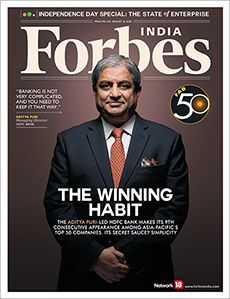
The fabulous set of Asia-Pacific's finest companies
India continues to give competition to China on the Fab 50 list, finishing second in terms of number of firms for the fifth year in a row
If there has been turmoil of late in the Chinese stock markets, that’s certainly not in evidence in the Fab 50 list this year. The dominance of China continues in the 10th anniversary of the much-awaited Forbes Asia roll call of Asia-Pacific’s finest public companies. As if on cue to mark this important occasion, China puts up as many as half the number of companies in the coveted list this year, its highest ever and up sharply from 16 last year.

The Fab 50 you will read about in this issue is drawn from a pool of 1,116 public companies with annual revenue or market cap of at least $3 billion. These companies, which must be publicly traded for at least a year, are subjected to rigorous financial measures, and thereafter become part of a robust list of the finest in the Asia-Pacific region. Companies with high debt, those more than 50 percent state owned or those that are majority owned by listed parent companies, are excluded.
While China clearly stands out, India continues to give it competition, finishing second in terms of number of companies for the fifth year in a row. At 10 companies, the Indian tally has, however, fallen by two from last year. Within the Indian contingent, the Aditya Puri-led HDFC Bank, the subject of the cover story in this issue, finishes with as many as nine Fab 50 appearances, having debuted a year after these listings began. This is more than any other company on the list, and shows the resilience of the country’s second largest private sector bank.
On the occasion of India’s 69th Independence Day celebrations this year, we also take a close look at the state of enterprise in the country. Is the government doing enough to help unleash entrepreneurial energies? Have there been enough initiatives taken to improve India’s dismal rankings on the ease of doing business? The report card, as we find, has been mixed. While the government is taking steps to free up bureaucratic red tape, several other challenges remain to be met before India can truly claim to be an entrepreneurship-friendly nation. The good news, however, is that a refreshing set of young, risk-taking entrepreneurs, with a keen eye for innovation, is emerging on the scene, using technology to disrupt business models and drive deep-rooted change. As a country, we need to celebrate these entrepreneurs and ensure many more join their ranks, creating employment and providing economic independence to millions of Indians.
Best,
Sourav Majumdar
Editor, Forbes India
Email:sourav.majumdar@network18publishing.com
Twitter id:@TheSouravM
(This story appears in the 21 August, 2015 issue of Forbes India. To visit our Archives, click here.)
Post Your Comment















